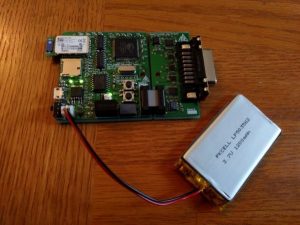Summary of Design and Implementation of a 12 Lead Portable ECG
The project developed a compact, battery-powered 12-lead electrocardiogram (ECG) device at McMaster University during 2016-2017, winning first place in the biomedical category. The device features careful component selection for compactness, robust mechanical design, good analog performance, useful connectivity, and a user-friendly interface. Battery power with isolated DC-DC conversion provides safety and rechargeability. The system handles signal conditioning, analog-to-digital conversion, and data transfer, displayed through a software graphical interface. Low-cost patient cables were adapted using continuity testing for electrode connections.
Parts used in the 12-lead Electrocardiogram Project:
- Battery (rechargeable)
- Isolated DC-DC converter
- 3.3V linear voltage regulator
- Signal conditioning circuitry
- Analog-to-digital converter (ADC)
- Microcontroller/processor for data handling
- DB15 connector
- ECG cables with button snap connectors
- 3M Red Dot silver-silver chloride electrodes
During the academic year of 2016-2017 at McMaster University, in conjunction with Dr. DeBruin, Christina Riczu, Thomas Phan and Emilie Corcoran, we developed a compact, battery powered, 12-lead electro-cardiogram. The project won 1st place in the biomedical category at the ECE Capstone Poster Day.
The final report we handed in for the course is attached at the end of this post and includes background information, a design overview, schematics and bill of materials for the hardware we developed. This post will introduce the project and serve as a personal account of the considerations and problems associated with the portion of the project that I focused on.
Before we begin I should note that if you decide to replicate this design or develop a derived design that you are doing so at your own risk. Attaching a device with a low impedance connection to a person can be dangerous. We developed this project under a supervisor with experience developing and maintaining such devices and protocols were put into place to ensure safety.
System Design
My goal during the project was to develop the most compact device possible while providing robust mechanical design, usable battery life, convenient connectivity, a clean user interface, and good analog performance. For this to occur components must be selected carefully across electrical, mechanical and software domains. In addition to this I wanted the design to be reusable and extendable in the future, choices were made to allow the circuit boards to be used for different applications beyond this project.
Overview
The purpose of the hardware is to perform signal conditioning, analog to digital conversion and transfer the data to a host.
The software processes the data and displays it in a graphical interface.
Patient Interface
Low cost cables for connecting skin electrodes to a data acquisition system is available on EBay. If you search for Contec ECG cable on EBay you will find them for about $20. They interface with a DB15 connector and come terminated with button snap connectors for connecting with commonly available ECG electrodes such as the 3M Red Dot silver-silver chloride electrodes.
We could not find a pin out for the cable so we used a continuity meter to figure it out, I include it here in case anyone needs it.
Electrical
We begin with electrical component selection as this dictates the direction we must go for mechanical and firmware integration.
Isolated Power
As mentioned before, electrical isolation is required for safety. Batteries can be used to provide a simple isolated supply, however, requiring the replacement of batteries puts an unnecessary burden on the user. We wanted the device to be convenient which meant we wanted the device to be battery powered and rechargeable even during use. This necessitated an isolated DCDC converter between the battery and electronics connected to the patient for safety.
The system was developed to allow the DCDC converter to be sized smaller thus allowing the device to fit into a smaller box. From the top-level schematics, you can see that some components are powered by the battery through a 3.3V linear regulator and only the components with a direct connection to the patient is powered by the isolated DCDC.
Read more: Design and Implementation of a 12 Lead Portable ECG

